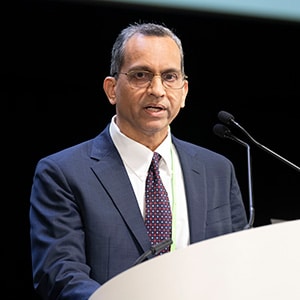For more than two decades, patients diagnosed with locally advanced head and neck squamous cell carcinoma (HNSCC) have been treated with the same game plan: surgery to remove the tumor, then radiation, often with chemotherapy, to wipe out any remaining cancer cells.

This approach has saved lives, but “outcomes for many patients continue to be unsatisfactory,” said Ravindra Uppaluri, MD, PhD, of the Brigham and Women’s Hospital, the Dana-Farber Brigham Cancer Center, and Harvard Medical School.
Uppaluri and his colleague Douglas Adkins, MD, of Washington University School of Medicine, set out to improve the situation by building on their previous study of immunotherapy in patients with surgically treated HNSCC.
During Sunday’s “Advances in Immunotherapy” Clinical Trial Plenary at the AACR Annual Meeting 2025, Uppaluri revealed potentially practice-changing results from the phase III KEYNOTE-689 clinical trial: immunotherapy before and after surgery can supplement standard-of-care treatments to increase tumor elimination prior to surgery as well as protect against relapse.
Immunotherapy’s Impact Before and After Surgery
Pembrolizumab (Keytruda) is a PD-1 immune checkpoint inhibitor that helps the immune system attack cancer cells, and this class of immunotherapies is already used in the treatment of patients with head and neck cancer that is metastatic or recurrent.
In this trial, Uppaluri and his team investigated their hypothesis that flanking surgery with perioperative pembrolizumab might enable the immune system to exert superior antitumor immunity.
“Before surgery, when tumor burden and antigen load are high, immunotherapy can enhance immune responses and start to act on tumor killing. After standard-of-care treatment, immunotherapy can address any leftover cancer cells that may still be present,” Uppaluri said.
In other words, hit the tumor hard when it is first found and at full strength, and then after the remaining bulk is resected, hit it again to mop up any stragglers.
To test whether this strategy could improve patient outcomes, the phase III trial enrolled 714 patients with resectable, previously untreated stage III or IV HNSCC, including in the larynx, hypopharynx, and oral cavity. All patients underwent surgery and adjuvant therapy (radiation and/or chemotherapy) according to their risk classification, and roughly half were randomly assigned to receive supplemental pre- and post-surgery immunotherapy.
In addition to evaluating how long patients stayed alive and cancer-free, Uppaluri’s team looked at rates of major pathologic response (mPR), meaning at least 90% of the tumor was destroyed at the time of surgery.
Fewer Recurrences, Greater Tumor Shrinkage
With half of patients having at least three years of follow-up, the results were very promising. The addition of pembrolizumab made a clear difference, improving the elimination of tumors prior to surgery and reducing the risk of cancer coming back compared to those treated with standard-of-care therapy alone. Patients with high PD-L1 expression, defined as a combined positive score of 10 or more, experienced a 13.7% increase in mPR rate and a 34% reduction in recurrence.

“This new information supports changing the current standard of care to now include neoadjuvant and adjuvant pembrolizumab. For the first time in more than 20 years, patients with this challenging disease have a new therapeutic approach,” Uppaluri claimed. He also praised the hundreds of patients worldwide who volunteered in the trial and made this breakthrough possible, paving the way to bring this regimen into routine care.
Looking Ahead
With perioperative immunotherapy proven effective in these patients, the team is focused on refining the strategy moving forward.
“Now that we know this is a safe approach, we can start thinking about how we can potentially modify surgery and/or the adjuvant therapy to try to reduce the challenges patients face from the side effects of our treatments,” Uppaluri said.
One outstanding question is which part of this “one-two” immunotherapy punch is most critical. Because KEYNOTE-689 administered pembrolizumab both before and after surgery, it is unclear whether the success stemmed predominantly from the pre-surgery dose or the post-surgery doses, or both. Future studies may try to answer this, Uppaluri said.
For patients and families facing head and neck cancer, these findings bring new hope. If the perioperative immunotherapy approach becomes widely adopted, more patients could experience long-lasting remissions or even cures.
The post Pembrolizumab’s Perioperative Power in Head and Neck Cancer appeared first on American Association for Cancer Research (AACR).



